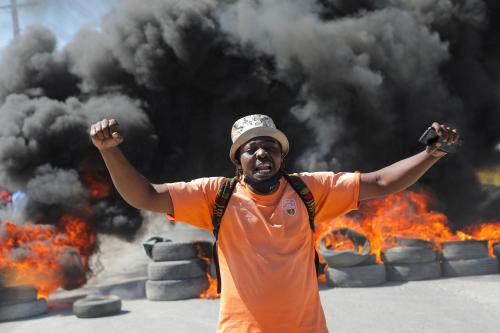The following is an excerpt from Reopening America: How to Save Lives and Livelihoods, a new report where Brookings experts offer ideas to help policymakers protect lives and save livelihoods in the midst of the current COVID-19 pandemic.
 U.S. law enforcement forces are among the crucial responders to the coronavirus pandemic. Intense policing duties amidst the pandemic have taken a severe toll on many police departments as some officers fell sick and had to quarantine and many had to work long hours or double their duties. COVID-19 has also affected crime patterns: It further suppressed street homicides though increased looting of closed stores, and has given a boost to online criminal activity, right-wing hate groups, and intimidation-embracing militias.
U.S. law enforcement forces are among the crucial responders to the coronavirus pandemic. Intense policing duties amidst the pandemic have taken a severe toll on many police departments as some officers fell sick and had to quarantine and many had to work long hours or double their duties. COVID-19 has also affected crime patterns: It further suppressed street homicides though increased looting of closed stores, and has given a boost to online criminal activity, right-wing hate groups, and intimidation-embracing militias.
Much as COVID-19 produces new law enforcement challenges and imperatives, including how states and countries will find resources to support local police forces amidst intense economic downturn, it also creates important opportunities to strengthen community policing and reinforce relations among communities and our law enforcement forces. As the United States starts reopening the country after the spring lockdown, I offer several guidelines for rethinking immediate priorities for domestic law enforcement.
PREPARE FOR NEW INFECTION WAVES
There is a substantial chance that as the United States and the world reopen, new clusters of COVID-19 and, worse yet, widespread reinfection will follow, as has happened in China, South Korea, and India. That may well necessitate renewed local and even national lockdowns. Enforcing their resurrection will be far harder than the first lockdown. People’s economic and psychological reserves for distancing have been substantially depleted. The obligations and sense of responsibility for one’s own health as well as public health that many felt and exhibited in the first lockdown will compete against sheer economic desperation and emotional exhaustion in any new near-term lockdown. Thus, there may well be a need for a far larger involvement of police forces in enforcing a new lockdown.
This will require that police departments focus on getting their forces healthy and adequately rested. Some police departments suffered widespread COVID-19 affliction. Among the worst hit, the Detroit police department, for example, had 180 officers who tested positive by mid-April out of a force of 2,800 tested by mid-April. Having 6 percent of the force test positive may not seem like much, but in fact such a rate caused widespread difficulties in rotation, performance quality, and compromised capabilities for interrogating suspects of violent crimes, in addition to imposing a heavy psychological toll on the police officers and their families. That rate is also almost 14 times higher than the known infection prevalence among all U.S. adults, though the latter may be significantly underestimated! Attrition in police 93 forces also came from the need to self-quarantine for police officers who came into contact with those infected by COVID-19: At a peak, 15 percent of NYPD officers had to stay home as a result of COVID-19 illness or need to self-quarantine. That number is now down to 5 percent. But new outbreaks of infection will again infect already tired police departments all over again.
Getting ready for wave two also means enhancing training and preparedness, including for managing tense social situations and intensified protests, and devising the appropriate enforcement tools for implementing lockdowns, such as escalating fines (not imprisonment) that induce compliance but do not entrap residents—already impoverished by COVID-19—in further debt. Enforcement of new lockdowns will need to be resolute, but not forceful.
Two kinds of social protest are particularly likely in a round two of lockdown: protests by poor marginalized communities whose economic struggles may be desperately compounded by COVID-19, such as African Americans; and protests by right-wing extremist groups. In responding to the protests by African Americans, police forces need to be particularly careful to avoid overreaction and brutality. In responding to protests by right-wing extremist groups, law enforcement needs to avoid under-reaction and an underestimation of the severe risks of violence and threats to U.S. rule of law and democracy such groups pose.
Meanwhile, however, there is also a significant opportunity to build up a cache of positive relations with local communities. In some instances, local communities experienced officers handing out masks and providing advice on COVID-19 instead of frisking and questioning. Enhancing efforts to strengthen positive relations with local communities and communities’ perception of the legitimacy of local police forces will create important relationship capital for dealing with social strife new lockdowns will produce. As counties start opening up, events such as “police and pancakes” that bring together community organizers, students, and police officers and which also practice exemplary social distancing (perhaps with the events being held only virtually) are one method. In turn, however, local communities should look for opportunities to express appreciation of their police forces for their commitment and struggles during the lockdown, similar to the appreciation they have shown to healthcare personnel.
REDUCE PRISON POPULATIONS
There are many reasons for reducing the size of the U.S. prison population, the highest in the world not only in absolute numbers, but also as a percentage of imprisoned per 100,000—a rate in which the United States greatly surpasses other notoriously aggressive jailers such as Russia, South Africa, Brazil, and China (not counting the Uighurs detained in China’s reeducation concentration camps). The reasons for reducing the number of U.S. prisoners include not only the economic costs of their incarceration, but also the prospective societal and basic justice benefits, in terms of improving the conditions of U.S. minorities, particularly African Americans who comprise a disproportionate number of U.S. prison population.
COVID-19 creates a new imperative: public health for prisoners, correction officers, and their communities. Although data are highly imperfect, it appears that the number of confirmed COVID-19 cases among the U.S. prison population is double the rate among all U.S. adults. In four U.S. states where extensive testing of prison populations was carried out—Ohio, Arkansas, Virginia, and North Carolina—nearly 3,300 prisoners tested positive for COVID-19 (worrisomely, 96 percent without symptoms). The Cook County Jail in Chicago became a tragic face of COVID-19 and hotspot of the virus, as did Marion Correctional Institution in Ohio where 80 percent of the prison population tested positive for COVID-19. Even in the absence of a pandemic, prison health facilities are poorly equipped to provide for adequate healthcare for prisoners, and particularly ill-suited to care for elderly prisoners.
Countries around the world, including those with brutal authoritarian regimes such as Iran, have responded by releasing prisoners, at least temporarily, to prevent COVID-19 afflicting prisoners and correction officers. The United States must resolutely take advantage of all options to release prisoners who can be released without threats to public safety and to provide safe correction facilities to those who cannot be released. The Brennan Center for Justice compellingly argued in a 2016 study that 39 percent of inmates in state and federal prisons— about 576,000 people—could be safely released and that there was no compelling public safety reason to continue keeping them imprisoned. COVID-19 makes releasing them an even greater imperative.
Prime candidates for release include: nonviolent drug offenders; elderly prisoners who, as a result of their age, are not only highly vulnerable to succumbing to COVID-19 but are also extremely unlikely to reoffend; those severely ill with other illnesses; and other nonviolent prisoners, such as those who committed certain white-collar or lowlevel theft offenses and who can be placed under house arrest with their families and monitored with an ankle bracelet or other electronic monitoring.
Crucially, however, the crucible of COVID-19 should make us avoid repopulating U.S. correction facilities—well beyond COVID-19. Nonviolent public offenses should be handled as much as possible through non-incarceration sanctions such as fines, house imprisonment, social service, and other mild, but swift and certain, penalties that have proven highly effective in reducing various forms of crime and substance abuse.
DOUBLE DOWN ON PROSECUTING DOMESTIC VIOLENCE
The COVID-19 lockdowns have had different effects on various kinds of crimes. Separating rival gangs and keeping gang members at home where they could not get into honor and turf fights with their rivals reduced violence. Domestic violence, however, inevitably goes up when families are locked up together in the same quarters—whether during holidays and vacation times or pandemics.
Time together exacerbates disagreements without providing the outlet of separation. The coronavirus destabilizes families’ financial situations, keeps children from going to schools and limits access to healthcare, kids’ opportunities for play, and adults’ time apart. COVID-19-induced lockdowns and restrictions on accessing public spaces increase both stress at home and the tools of abuse. Egregious domestic abusers seek to control their victims by isolating them from family, friends, and sometimes even employment—maintaining constant surveillance over them, and controlling all aspects of their lives, such as clothing and food.
Isolation, such as that due to COVID-19, also weakens support networks. Police officials may be unavailable to come to a home where violence is reported. They may not be able to remove either the perpetrator or the victim, since jails are emptied and shelters shuttered. Close quarters may prevent the privacy often required for victims to report abuse.
Indeed, around the world and in the United States, domestic abuse went up during the COVID-19 lockdowns. In Spain, domestic abuse reports went up 18 percent in the first two weeks of COVID-19 lockdown. Similar reports have come from Italy, France, the United Kingdom, and China. In the United States, the rise in reports of domestic violence leveled off and declined during the later stages of the lockdown, but rather than reflecting an actual drop in incidents, the drop in reporting may reflect the inability of victims to report.
The coronavirus pandemic will continue to impose new and growing challenges for policing, including a likely rise in crime. But it presents new opportunities for strengthening citizens’ safety and improving relations between our communities and our law enforcement.
An important focus for police departments is following up on households where violence had been reported, prosecuting offenders, and proactively trying to encourage victims to come forward and report offenses as they become able 96 to leave their home. This provides an opportunity not only to deliver delayed justice when officers are not able to respond to distress calls during the lockdowns but also to prevent further abuse. Deterrence critically hinges of the prevalence rate of effective prosecution. In homicides, deterrence is sometimes believed to require at least a 40 percent effective prosecution rate. Whatever the actual number of effective prosecution rate for domestic crimes is, if prosecution is sporadic, deterrence is not created even when penalties are high.
The awful risks of greater domestic violence are not a reason to fail to implement new lockdowns— such new lockdowns will be necessary for important public health reasons. But there can be much better protection and prevention measures in place before the second wave of COVID-19: Shelters for victims of domestic abuse can be designated as essential services that do not shut down. But shelters, like all crowded spaces, such as dormitories and prisons, carry a high risk of infection. It is better to hire hotel rooms as temporary shelters that allow for social distancing and safety from both abusers and COVID-19 spread, as some European governments have done.
The coronavirus pandemic will continue to impose new and growing challenges for policing, including a likely rise in crime. But it presents new opportunities for strengthening citizens’ safety and improving relations between our communities and our law enforcement.





Commentary
Reopening America: Immediate domestic law enforcement priorities
May 28, 2020